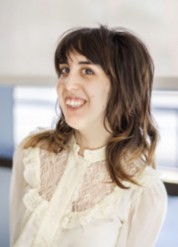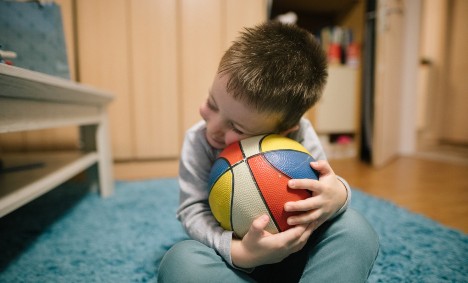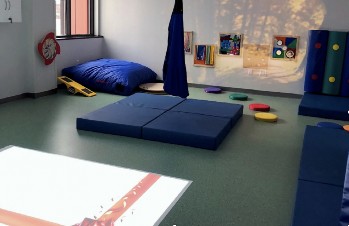WHAT'S HAPPENING
FILM FEST OUTREACH COORDINATOR FINDS HER DREAM JOB
BY LOLA DINIZIO
I had imposter syndrome before I could be an imposter. Any adult professional aspirations felt beyond my reach, untouchable, wrong – having a dream job felt presumptuous. I have cerebral palsy, comprising of major nerve damage to my lower facial nerves. I am unable to physically speak, although "normally" functioning otherwise
How, I thought, could I work in an any office environment if I couldn't take a phone call? Make a presentation? Speak to my peers? Be taken seriously?
I hate writing about my disability. There's always a perverse desire to end on a galvanizing note; to lean heavily on the word "despite". "Despite my cerebral palsy, I am a successful freelancer! Despite life-long discrimination, I am still a highly functioning member of society! Despite the rampant bias in the hiring process, I've desperately crawled my way up into eking out some sort of a career for myself, occasionally at the expense of my dignity and personal sanity!" Look at how well I'm doing, look how great I am at having a disability. So what if I can't talk? "So, why can't you talk?" an interviewer asked me, glancing distractedly around the room packed with posters of a well-known talk show host beaming down at us.

SPEAKING VOLUMES: Lola DiNizio: "I get to connect to hundreds of disability-based organizations and push the festival's outreach. The irony — a woman who can't speak specializing in communications.".
"Cerebral palsy!" I wrote, trying to put a jaunty, exclamation mark-littered flair in my panicked half-cursive. Cue rehearsed script: "But I assure you, it've never affected me professionally! If anything, it's an asset!" "Uh-huh. Interesting. Well, we're still considering candidates and uh we'll get back to you if…" Whatever. I know the ADA prohibits prospective employers from asking about the nature of your disability. But am I going to call him out? File a complaint and blow all chance of landing this gig? Nope. I later found out I wasn't hired because I couldn't use a walkie-talkie onset. Was that an essential job function not covered by the ADA, providing just cause not to hire me? I don't know, but I know how enraged I felt.
I've struggled to find work my whole life. This can't be attributed solely to not being able to talk. I have my strengths and weaknesses and like every other frenzied job seeker, I've sent hundreds of applications via the LinkedIn "Easy Apply" button (does that ever work for anyone?). There's a maddening tightrope walk of self-doubt: am I being discriminated against or does my application just not stand out? Do I mention my disability in my cover letter or wait for the interview to drop the bomb?
Following my graduation from Columbia, I spent a manic year job searching. Hundreds of job applications, a handful organizations hitting me back. I toed the brink of complete moral bankruptcy when I interviewed at a nefarious, far-right news think tank. Fortunately for the sake of my moral soul, I wasn't called for a second round.
I hesitated to go through a disability employment service. I occasionally engage in pride to the point of hubris – and in both a denial and rejection of my disability, I wanted to do things the "right way", like all my abled-bodied friends did. Hustle, apply for jobs, interview, bam, get paid. Even if it's a job I hated, I didn't care. However, I eventually accepted that I direly needed help. My Godmother referred me to ADAPT Community Network in NYC. They connected me to the ReelAbilities Film Festival who shortly, and to my immense relief, hired me as an outreach coordinator.
ReelAbilities is the world's premiere film festival by/for/about people with disabilities. I'm not bluffing, even though my boss is reading this, when I say I love this job. I get to connect to hundreds of disability-based organizations and push the festival's outreach. The irony – a woman who can't speak specializing in communications.
This year, we're screening two films that pertain both to my experience and to the mission of the CDE: Don't Foil My Plans, about a man with autism navigating building an independent life, and 25 Prospect Street, a behind-the-screens look at a nonprofit movie theater in Connecticut with a mission of meaningful employment for people with disabilities.
While it's true that I've only been treated as an equal at a ReelAbilities, I want it appreciated, not celebrated. This should be the norm. I sincerely hope through the screenings of our films, we can present a small slice of the non-singular disability experience.
ABOUT REELABILITIES FILM FESTIVAL:
ReelAbilities Film Festival is the largest festival in the US dedicated to promoting awareness and appreciation of the lives, stories and artistic expressions of people with different disabilities. Founded in NY in 2007, the festival presents award winning films by and about people with disabilities in multiple locations throughout each hosting city. Post-screening discussions and other engaging programs bring together the community to explore, discuss, embrace, and celebrate the diversity of our shared human experience.
ASHA: 10 WAYS CHILDREN WITH LANGUAGE DISORDERS CAN MAINTAIN PHYSICAL DISTANCE & SOCIAL CONNECTION DURING THE CORONAVIRUS PANDEMIC

HAVING A BALL: Parents can help children with language disorders to keep a safe physical distance without losing social nearness that is so critical to their development.
With social distancing, or more accurately physical distancing, becoming a new way of life as COVID-19 cases grow by the day, people of all ages are challenged to find different ways to connect socially.
However, for children with language disorders – who have difficulties with social interactions in the best of times – the physical distance mandated to prevent the pandemic's spread can be specially challenging, says the American Speech-Language-Hearing Association (ASHA) asha.org
In-person social interactions are now restricted for most Americans – but people have found resourceful and creative ways to extend and strengthen their social bonds," extend and strengthen their social bonds," according to Diane Paul, PhD, CCC-SLP, ASHA Director of Clinical Issues in Speech-Language Pathology. "Children and adults are using technology tools to foster connection and build solidarity: using video platforms for playdates, happy hours, and meetings; sharing relatable memes and jokes through email, social media, and texting; attending streamed worship services, fitness classes, and art and music lessons; and more."
However, children with language disorders may not be able to adapt as quickly as others, Paul wrote in an ASHA blog post ( blog.asha.org/2020/03/27/10-ways-children-with-language-disorders-can-maintain- both-physical-distance-and-social-connection/) published today. "For example, difficulty with social communication is one of the core characteristics of autism. Such communication problems may be exacerbated by social distancing. Physical distance, though, does not have to mean social distance – even for children with language disorders."
Speech and language disorders are among the most common disabilities children face – including toddlers and school-age children. Some children may be missing invaluable treatment sessions with their speech-language pathologist during this time, due to logistical, legal, and other barriers to providing treatment. Others may be able to connect via virtual sessions. Although these changes can be stressful, parents can help children interact socially during this time in the following ways:
1. Screen time. Realistically, screen usage will increase while people are sheltering at home. Some research shows that screen time can lead to speech and language delays in children. But TV shows, movies, and social media can be viewed in a way that optimizes social interaction. When possible, use these technologies interactively: Watch shows/movies together, and discuss them (e.g., Who was your favorite character? What do you think will happen next? Why did the show end that way?). Ask kids to introduce you to their favorite video game or TikTok personality.
2.Conversation opportunities. Although families may be together more than usual, parents may be focused on financial, medical, work, and other significant responsibilities and concerns. But conversation-rich opportunities can occur in everyday tasks that are already occurring, such as cooking/dinner prep (following a sequence of steps) or traditional activities that families are rediscovering as everyone hunkers down (e.g., board games offer a chance to talk about rules and turn-taking).
3.Reading. This time of relative isolation can lend more time for reading. But this doesn't have to be a solitary activity. Families can read to each other and find different types of book online. Young children can play rhyming and word games. Parents can ask older children questions to guide their understanding (e.g., What happened at the beginning, middle, and end of the story? What was the main plot? What motivated each character?)
What was the main plot? What motivated each character?) 4.Being with friends and family. The importance of communicating with friends and extended family during this time cannot be understated. Children with language disorders may find phone and FaceTime/Zoom communication more challenging than others. Parents can practice conversations in advance and can suggest topics and related responses (e.g., making comparisons between the weather in different cities; talking about home school experiences). They can involve siblings and discuss ways that they can help their sibling who has a language disorder.
5.Understanding changes. The changes in daily routines may be particularly hard for children with language comprehension and production problems. They may hear alarming news reports or sense the tension of their parent(s) – but they may not have the ability to ask their questions, express their feelings, or speak about this confusing time. Parents can define new vocabulary words (e.g., coronavirus, COVID-19, social distancing, quarantine, sheltering at home) and can explain changes in routine. Parents can establish a new routine, as much as possible, and can involve a and can involve a child in decision making (e.g., When would you like to call grandma and pop-pop? Which friend should we talk to today? What food would you like?).
6.Creativity. Dance, music, art, and other classes that kids may have been taking in person are now virtual, offering a great opportunity to continue the connection with those teachers and friends. And online drawing, cooking, and other tutorials are plentiful. Low-tech possibilities to use creativity and practice language skills include having a child pick out items around the house and create their own store; planning an indoor camping night (e.g., making a list of what they'll need, ideas for things they want to do); and planning and planting a garden.
7.Physical activity. Gyms, personal trainers, and community fitness programs are providing content online. Parents and children can use these activities as a way to bond together and as topics of conversation (e.g., different types of exercises, healthy eating, connection between physical activity and wellness). Or they can take up a new form of exercise and learn it together via televised on-demand or online programs (e.g., family yoga). Some family-friendly neighborhoods have organized circuit training stops at various houses (posting a different exercise on each front/garage door) so families can get in shape and share a neighborhood-based social activity without actually interacting physically.
8.Humor. Many people have been sharing or receiving humorous COVID-related memes and videos to ease tension and connect with others. Children with language disorders may miss some of these coping opportunities because they tend to miss the nuances of humor. Parents can help them better understand humorous anecdotes or jokes by talking through them. Jokes are a sophisticated form of communication – what a great learning opportunity!
9.Organizing. Some households are undertaking decluttering and organizing projects that have been on the back burner for years. These can be language lessons, too. What items go together? Do you remember when you wore that outfit? Will you play with that toy anymore?
10. Augmentative and alternative communication (AAC). Some children with language disorders use AAC to help them communicate (e.g., letter boards, speech-generating devices). Parents should make sure that kids are using their AAC devices at home, at all times. These devices are not just for school.
Although this is a difficult time for all, parents can help children with language disorders to keep a safe physical distance without losing social nearness that is so critical to their development. Learn more at asha.org/public.
Note: This is a modified version of a post originally published via the ASHA Leader Live blog.
ABOUT ASHA: The American Speech-Language-Hearing Association (ASHA) is the national professional, scientific, and credentialing association for 211,000 members and affiliates who are audiologists; speech-language pathologists; speech, language, and hearing scientists; audiology and speech-language pathology support personnel; and students.
SCHOOL FOR AUTISM AND SCHOOL FOR THE DEAF KEEPS FAMILIES TOGETHER
Pressley Ridge's new School for Autism and School for the Deaf on the North Side of Pittsburgh not only encourages its students to reach their fullest potential, it allows them to engage and thrive in meaningful relationships with their family.

BREATHING ROOM: The schools feature two sensory rooms that include adjustable strobe lighting, textiles, swings, and other sensory objects designed to help the students regulate.
The schools provide youth ages 6-21 with intensive social, behavioral, and academic interventions to learn the skills they need to interact with others and successfully participate in their community.
Two families in particular – the Wallens and their son Peter of Cleveland, Ohio and the Hudaks and their son, Victor López, of Pittsburgh, PA – have learned firsthand the difficulty of navigating the system to find appropriate placement for children with comorbid conditions, such as deafness and autism. In trying to help their sons, both families have faced the challenges of behavioral outbursts, physical altercations, hospitalizations, and the judgment of others who do not understand these conditions. However, with determination and persistence, they found Pressley Ridge.
Mary Catherine (MC) and John Wallen built their large family of 14 partially through foster care and adoption, as was the case with their son, Peter, who is profoundly deaf and autistic. He had been living with his grandparents, who also are deaf, until they could no longer handle his outbursts. The Wallens had already adopted Peter's 11-month-old twin sisters, so welcoming him into their family was an obvious choice. By second grade, however, Peter had attended five different schools for hearing-impaired children, and they realized that they had to seek services elsewhere. Unable to locate a program in Ohio, they turned to Pressley Ridge.
Families from as far away as Puerto Rico also have found their way to Pressley Ridge. Wendy Hudak, then a single mother living in Puerto Rico, noticed signs of autism in her son Victor when he was around 18 months old. A neurologist eventually confirmed that he was on the autism spectrum. She immediately began to search for resources to help him, but the best she could find was a half-day preschool program. Following months of expensive therapies and taking on the almost full-time job of caring for a nonverbal child with autism, Wendy realized the situation was not sustainable. Her sister lived in Pittsburgh and recommended a local program. So, Wendy and Victor moved to Pine-Richland School District, where Victor attended kindergarten through sixth grade, when the district's autism support services ended. Wendy had learned about the Pressley Ridge School for Autism and decided to enroll him full time. As Victor grew older and his needs became more challenging, he moved to Pressley Ridge's Home Places residential treatment program. The opening of the new facility for the Pressley Ridge School for Autism and School for the Deaf in the fall of 2019 created even more opportunities for Victor to live a productive and enjoyable life. The new $12 million school building was designed with the help of experts in autism and deafness.
The classrooms for both the School for Autism and School for the Deaf include SmartBoard technology, restroom facilities, and calming areas. There are also two sensory rooms that feature adjustable strobe lighting, textiles, swings, and other sensory objects designed to help the students regulate. These resources and the staff at Pressley Ridge have allowed children like Peter and Victor to acquire the skills to establish a place within their community and maintain loving and productive relationships with their family.
In the four years Peter has attended the School, he has learned how to push through negative triggers, better control his emotions, and respond more appropriately in social sit uations. Peter lives in the School for the Deaf residential cottages year-round, yet he remains an integral part of his family and stays connected to his grandparents, traveling back to Ohio two weekends per month.
Wendy Hudak and her husband, Mark, also attribute Victor's ability to successfully function in the community to the Pressley Ridge staff. As a resident, Victor participates in academics and a variety of vocational opportunities, including helping out at a pizza shop and a thrift store. He successfully transitions between school and home and attends every family celebration. "The staff at Pressley Ridge have helped him grow so much from those difficult years. He now has an enjoyable and productive life," said Wendy. Victor, now 19, can remain at Pressley Ridge for two more years, and then Pressley Ridge will help the Hudaks find another residential facility where he can maintain his independence.
For more information on Pressley Ridge, visit pressleyridge.org.•